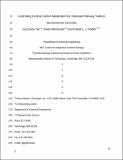Controlling Central Carbon Metabolism for Improved Pathway Yields in Saccharomyces cerevisiae
Author(s)
Tan, Sue Zanne; Manchester, Shawn; Prather, Kristala L
DownloadPrather_Controlling Central.pdf (1.534Mb)
PUBLISHER_POLICY
Publisher Policy
Article is made available in accordance with the publisher's policy and may be subject to US copyright law. Please refer to the publisher's site for terms of use.
Terms of use
Metadata
Show full item recordAbstract
Engineering control of metabolic pathways is important to improving product titers and yields. Traditional methods such as overexpressing pathway enzymes and deleting competing ones are restricted by the interdependence of metabolic reactions and the finite nature of cellular resources. Here, we developed a metabolite valve that controls glycolytic flux through central carbon metabolism in Saccharomyces cerevisiae. In a Hexokinase 2 and Glucokinase 1 deleted strain (hxk2Δglk1Δ), glucose flux was diverted away from glycolysis and into a model pathway, gluconate, by controlling the transcription of Hexokinase 1 with the tetracycline transactivator protein (tTA). A maximum 10-fold decrease in hexokinase activity resulted in a 50-fold increase in gluconate yields, from 0.7% to 36% mol/mol of glucose. The reduction in glucose flux resulted in a significant decrease in ethanol byproduction that extended to semianaerobic conditions, as shown in the production of isobutanol. This proof-of-concept is one of the first demonstrations in S. cerevisiae of dynamic redirection of glucose from glycolysis and into a heterologous pathway.
Date issued
2015-11Department
Massachusetts Institute of Technology. Department of Chemical EngineeringJournal
ACS Synthetic Biology
Publisher
American Chemical Society (ACS)
Citation
Tan, Sue Zanne, Shawn Manchester, and Kristala L. J. Prather. “Controlling Central Carbon Metabolism for Improved Pathway Yields in Saccharomyces Cerevisiae.” ACS Synthetic Biology 5.2 (2016): 116–124.
Version: Author's final manuscript
ISSN
2161-5063
2161-5063